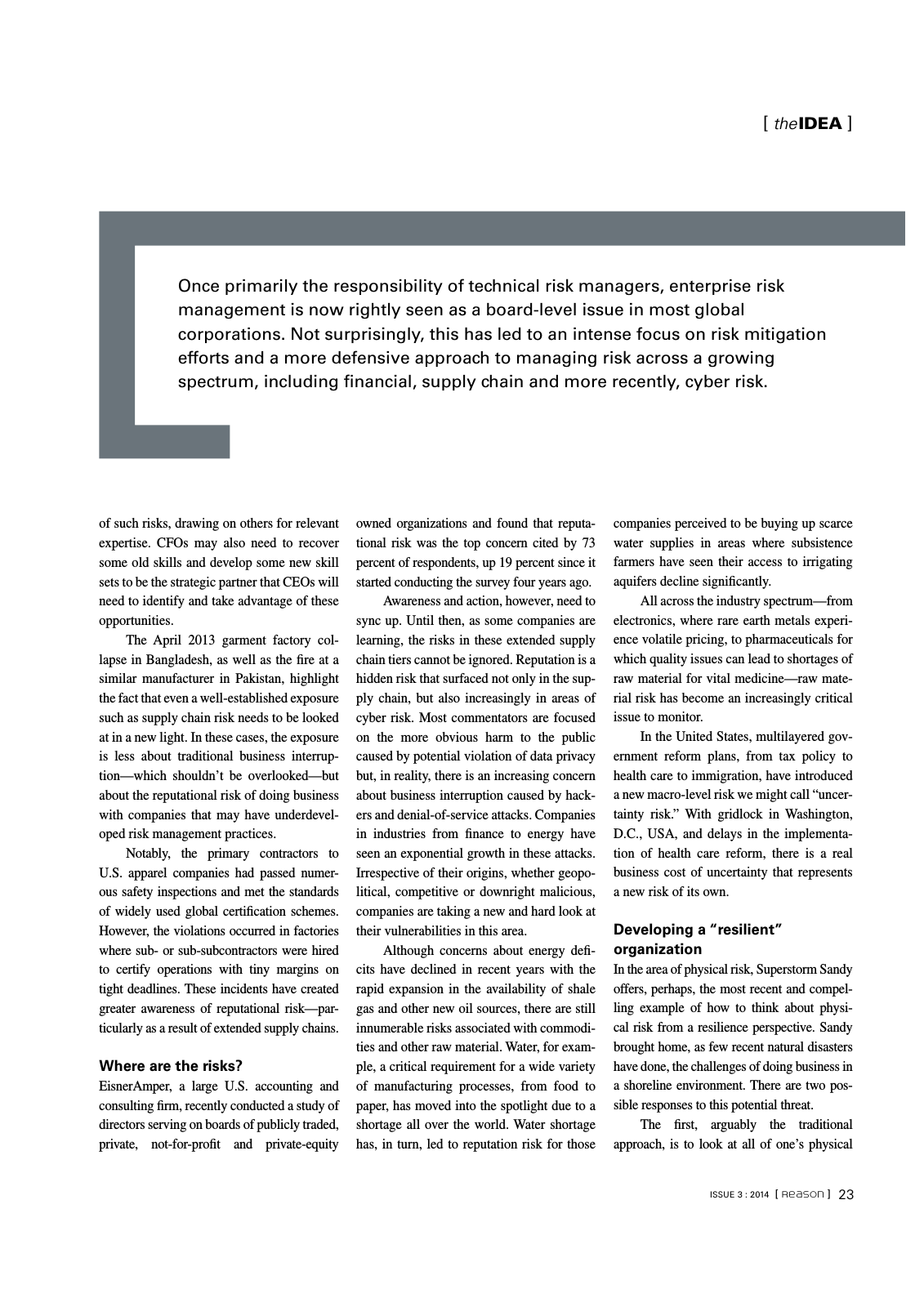Reason Magazin 2014Q3 Seite 23
Hinweis: Dies ist eine maschinenlesbare No-Flash Ansicht.Klicken Sie hier um zur Online-Version zu gelangen.
Inhalt
Once primarily the responsibility of technical risk managers enterprise risk management is now rightly seen as a board level issue in most global corporations Not surprisingly this has led to an intense focus on risk mitigation efforts and a more defensive approach to managing risk across a growing spectrum including financial supply chain and more recently cyber risk of such risks drawing on others for relevant expertise CFOs may also need to recover some old skills and develop some new skill sets to be the strategic partner that CEOs will need to identify and take advantage of these opportunities The April 2013 garment factory col lapse in Bangladesh as well as the fire at a similar manufacturer in Pakistan highlight the fact that even a well established exposure such as supply chain risk needs to be looked at in a new light In these cases the exposure is less about traditional business interrup tion which shouldn t be overlooked but about the reputational risk of doing business with companies that may have underdevel oped risk management practices Notably the primary contractors to U S apparel companies had passed numer ous safety inspections and met the standards of widely used global certification schemes However the violations occurred in factories where sub or sub subcontractors were hired to certify operations with tiny margins on tight deadlines These incidents have created greater awareness of reputational risk par ticularly as a result of extended supply chains Where are the risks EisnerAmper a large U S accounting and consulting firm recently conducted a study of directors serving on boards of publicly traded private not for profit and private equity owned organizations and found that reputa tional risk was the top concern cited by 73 percent of respondents up 19 percent since it started conducting the survey four years ago Awareness and action however need to sync up Until then as some companies are learning the risks in these extended supply chain tiers cannot be ignored Reputation is a hidden risk that surfaced not only in the sup ply chain but also increasingly in areas of cyber risk Most commentators are focused on the more obvious harm to the public caused by potential violation of data privacy but in reality there is an increasing concern about business interruption caused by hack ers and denial of service attacks Companies in industries from finance to energy have seen an exponential growth in these attacks Irrespective of their origins whether geopo litical competitive or downright malicious companies are taking a new and hard look at their vulnerabilities in this area Although concerns about energy defi cits have declined in recent years with the rapid expansion in the availability of shale gas and other new oil sources there are still innumerable risks associated with commodi ties and other raw material Water for exam ple a critical requirement for a wide variety of manufacturing processes from food to paper has moved into the spotlight due to a shortage all over the world Water shortage has in turn led to reputation risk for those companies perceived to be buying up scarce water supplies in areas where subsistence farmers have seen their access to irrigating aquifers decline significantly All across the industry spectrum from electronics where rare earth metals experi ence volatile pricing to pharmaceuticals for which quality issues can lead to shortages of raw material for vital medicine raw mate rial risk has become an increasingly critical issue to monitor In the United States multilayered gov ernment reform plans from tax policy to health care to immigration have introduced a new macro level risk we might call uncer tainty risk With gridlock in Washington D C USA and delays in the implementa tion of health care reform there is a real business cost of uncertainty that represents a new risk of its own Developing a resilient organization In the area of physical risk Superstorm Sandy offers perhaps the most recent and compel ling example of how to think about physi cal risk from a resilience perspective Sandy brought home as few recent natural disasters have done the challenges of doing business in a shoreline environment There are two pos sible responses to this potential threat The first arguably the traditional approach is to look at all of one s physical the IDEA ISSUE 3 2014 Reason 23
